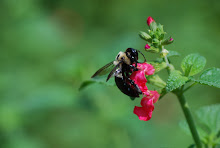
Last Tuesday a group of folks from the Georgia Plant Conservation Alliance, which is a diverse group of organizations throughout the state that have come together to meet plant conservation goals, met near Toccoa to plant endangered Echinacea laevigata and other native wildflowers in North Georgia. The hard work had been done – clearing some trees on the hillsides to allow the sunlight in for these perennials to thrive and reestablish in North Georgia forests. In our group today were Heather and Jennifer, botanists from The State Botanical Garden of Georgia, A botanist from the DNR Heritage Program, a few US Forest Service biologists, volunteers from the Georgia Plant Conservation Alliance, who donate countless hours to help plant and monitor these populations, and me. I needed this to complete my 16 required hours of volunteer time so I can be in the second graduation class receiving a Certificate in Native Plants from the State Botanical Garden. I also needed this time in the woods and away from my to-do lists. Never mind the temperatures in the 40s and drizzly rain. I agreed with Liese – I’d take that cold, wet day over the heat and insects of July.
The 250+ plants brought with us were grown from seed collected in Georgia and grown at The State Botanical Garden of Georgia - Echinacea laevigata, Hypericum punctatum (St. John’s wort), Symphyotrichum georgianum (Georgia aster – a threatened species in Georgia with purple flowers in fall), and Oligoneuron (white-top solidago, which has clusters of little white flowers that look like asters or daisies, not the solidago that is commonly called goldenrod).
 The first site was on a steep slope. We didn’t even need to kneel down to plant the seedlings – just lean forward a little to dig the holes and set in the perennials. Although each site access became easier that morning the weather got wetter and wetter – and colder. By the end we were pretty soaked, but feeling good about what got into the ground and the condition of the plants that were planted there before and are now established. Details were recorded and the sites will be visited to monitor the survival rate. The goal is that these plants not just survive, but reproduce and reestablish colonies throughout this area. In another county in North Georgia, native bog orchids and pitcher plants have started to reproduce on their own, a significant success for the folks of the Georgia Plant Conservation Alliance.
The first site was on a steep slope. We didn’t even need to kneel down to plant the seedlings – just lean forward a little to dig the holes and set in the perennials. Although each site access became easier that morning the weather got wetter and wetter – and colder. By the end we were pretty soaked, but feeling good about what got into the ground and the condition of the plants that were planted there before and are now established. Details were recorded and the sites will be visited to monitor the survival rate. The goal is that these plants not just survive, but reproduce and reestablish colonies throughout this area. In another county in North Georgia, native bog orchids and pitcher plants have started to reproduce on their own, a significant success for the folks of the Georgia Plant Conservation Alliance.
Saving the Smooth Coneflower (Echinacea laevigata) is one of the original priority projects of the Georgia Plant Conservation Alliance. Read Heather Alley’s 2002 account here.
The 250+ plants brought with us were grown from seed collected in Georgia and grown at The State Botanical Garden of Georgia - Echinacea laevigata, Hypericum punctatum (St. John’s wort), Symphyotrichum georgianum (Georgia aster – a threatened species in Georgia with purple flowers in fall), and Oligoneuron (white-top solidago, which has clusters of little white flowers that look like asters or daisies, not the solidago that is commonly called goldenrod).
 The first site was on a steep slope. We didn’t even need to kneel down to plant the seedlings – just lean forward a little to dig the holes and set in the perennials. Although each site access became easier that morning the weather got wetter and wetter – and colder. By the end we were pretty soaked, but feeling good about what got into the ground and the condition of the plants that were planted there before and are now established. Details were recorded and the sites will be visited to monitor the survival rate. The goal is that these plants not just survive, but reproduce and reestablish colonies throughout this area. In another county in North Georgia, native bog orchids and pitcher plants have started to reproduce on their own, a significant success for the folks of the Georgia Plant Conservation Alliance.
The first site was on a steep slope. We didn’t even need to kneel down to plant the seedlings – just lean forward a little to dig the holes and set in the perennials. Although each site access became easier that morning the weather got wetter and wetter – and colder. By the end we were pretty soaked, but feeling good about what got into the ground and the condition of the plants that were planted there before and are now established. Details were recorded and the sites will be visited to monitor the survival rate. The goal is that these plants not just survive, but reproduce and reestablish colonies throughout this area. In another county in North Georgia, native bog orchids and pitcher plants have started to reproduce on their own, a significant success for the folks of the Georgia Plant Conservation Alliance.Saving the Smooth Coneflower (Echinacea laevigata) is one of the original priority projects of the Georgia Plant Conservation Alliance. Read Heather Alley’s 2002 account here.


